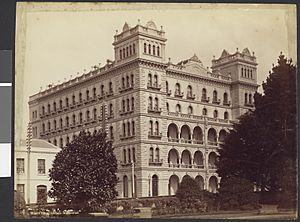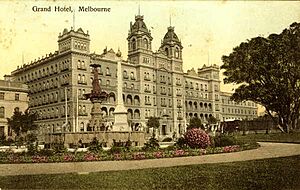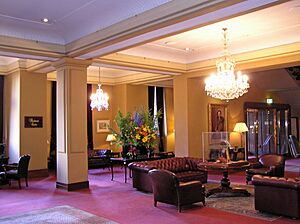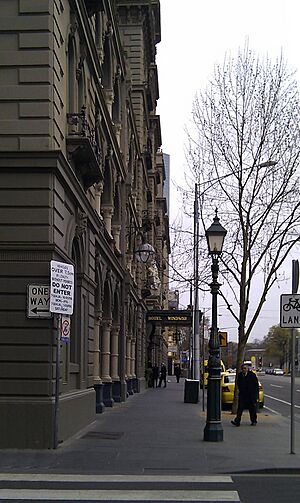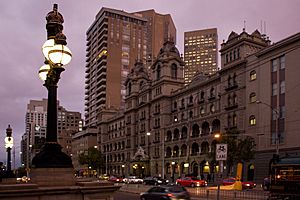Hotel Windsor (Melbourne) facts for kids
| Hotel Windsor | |
Quick facts for kids 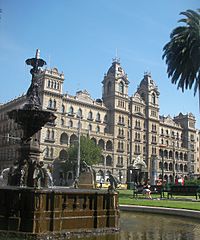 Hotel Windsor, 2010 |
|
| Hotel facts and statistics | |
|---|---|
| Location | 100–150 Spring Street, Melbourne, Victoria |
| Coordinates | 37°48′43″S 144°58′22″E / 37.81194°S 144.97278°E |
| Opening date | 1884 (Grand Hotel) 1888 (Grand Coffee Palace) 1897 (Grand Hotel) 1920 (Windsor Hotel) 2008 (Hotel Windsor) |
| Architect | Charles Webb |
| Management | Halim Group |
| Owner | Halim Group |
| No. of restaurants | 1 |
| No. of rooms | 180 |
| of which suites | 20 |
| Parking | off-site |
| No. of floors | 5 |
The Hotel Windsor is a fancy, old hotel in Melbourne, Victoria, Australia. It first opened its doors in 1884. It's special because it's the only "grand" hotel from the Victorian era (a time when Queen Victoria ruled) that was built for this purpose and is still standing in Melbourne today.
The Windsor hotel is located on Spring Street, near Parliament House. It's a famous example of beautiful Victorian architecture. For a long time in the 1900s, people called it the Duchess of Spring Street because it was one of the most popular and luxurious hotels in Melbourne. Many important people from Australia and around the world have stayed there. It has a 5-star rating.
Contents
History of the Hotel Windsor
The original hotel was built by a shipping businessman named George Nipper. It was designed by Charles Webb and finished in 1884. It was first called "The Grand." However, Nipper sold the building in 1886.
A new company, led by politicians James Munro and James Balfour, bought the hotel. Munro was a leader of the temperance movement, which encouraged people to avoid alcohol. He famously burned the hotel's liquor license in public! The hotel then became a "coffee palace" and was renamed the "Grand Coffee Palace."
The building was made much bigger in 1888. Charles Webb designed the new parts, which included a ballroom and a grand main staircase. The hotel also got its unique twin towers with special mansard roofs. Above the main entrance, there's a stone sculpture with figures representing 'Peace and Plenty'.
James Munro faced financial trouble in 1893. A new owner took over the hotel in 1897. The hotel was joined with a nearby building and got its liquor license back. Its name changed back to the Grand Hotel. In 1898, important meetings were held at the hotel. These meetings helped create the Constitution of Australia, which united the Australian states into one country. Many representatives stayed at the hotel during this time.
In 1920, the hotel was sold again. It was updated and renamed the "Windsor Hotel." This name honored the House of Windsor, the British Royal Family. For much of the 20th century, the hotel was known as the "Duchess of Spring Street." It remained one of Melbourne's most luxurious hotels.
Challenges and Survival
In the 1960s, new, modern hotels started to appear. The Windsor became less popular. To try and attract more guests, the Windsor bought and knocked down a nearby hotel. A new part of the Windsor was built in its place.
By the mid-1970s, the Windsor was quite old and worn out. Many other grand hotels from the 1800s in Australia had been pulled down. There were plans to demolish the Windsor too. In 1974, a proposal suggested building a tall tower on the site. However, the state government and a group called the National Trust opposed this. A special protest by workers, called a green ban, also helped save the building.
To make sure the hotel was preserved, the state government bought it in 1976. In 1980, they leased it to a hotel company called The Oberoi Group.
Restoration and New Owners
The Oberoi Group began a big restoration of the hotel in 1983. They spent a lot of money to bring back its beautiful 19th-century look. They restored the lobby, stairhall, and the Grand Dining Room. This restoration was one of the first major projects to save a historic building in Melbourne. It helped the Windsor become a leading five-star hotel again. Famous traditions like afternoon tea and the doorman in a top hat returned.
In 1990, the government sold the hotel to the Oberoi Group. Then, in 2005, Oberoi sold the hotel to the Halim family from Indonesia.
Plans for the Future
The Halim group wanted to update the Windsor. In 2008, they suggested a $45 million plan to modernize the inside. This plan was approved after talks with heritage groups. However, the work didn't start because of a big financial crisis around the world.
In 2009, the Halim group proposed a much larger project. They wanted to add 152 rooms and build a new, modern tower at the back of the hotel. This plan caused a lot of debate. The National Trust of Australia (Victoria) was worried. They felt the new tower would be too tall and would overshadow the historic part of the hotel. They also worried it would block views towards Parliament House.
After many discussions and appeals, the plans for the tower were approved in 2010. However, there were more delays and challenges. The owners kept asking for more time to start or finish the work. Heritage groups continued to express concerns about changes to the building's historic interior.
New rules were put in place in 2015 to limit building heights in the area. This meant the planned tower was now too tall. The owners tried to get more extensions to their permits. In 2016, they were given until March 2020 to finish the project. However, by August 2019, no major work had happened. The Minister for Planning refused another extension. The Halim group then said they would work with heritage groups to find a different solution for the hotel's future.
Notable Guests
Many famous people have stayed at the Hotel Windsor. These include leaders like Margaret Thatcher and members of the British Royal Family, such as George VI of the United Kingdom and Elizabeth Bowes-Lyon.
Famous actors like Meryl Streep, Anthony Hopkins, Gregory Peck, Laurence Olivier, Vivien Leigh, and Katharine Hepburn have also been guests. Dancers like Rudolph Nureyev and Dame Margot Fonteyn have stayed there.
Australian legends like opera singers Dame Nellie Melba and Dame Joan Sutherland, and cricketer Don Bradman, have also enjoyed the Windsor. Many Australian prime ministers, including Sir Robert Menzies, Malcolm Fraser, Bob Hawke, Paul Keating, and John Howard, have been guests too.


